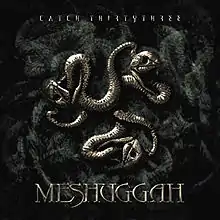Catch Thirtythree
Catch Thirtythree is the fifth album by Swedish heavy metal band Meshuggah. It was released on 16 May 2005 in Europe and on 31 May 2005 in North America, through Nuclear Blast. Catch Thirtythree entered the Billboard 200 chart at number 170.[7]
| Catch Thirtythree | ||||
|---|---|---|---|---|
 | ||||
| Studio album by | ||||
| Released | 16 May 2005 | |||
| Recorded | 2004–2005 | |||
| Studio | Fear and Loathing Studios, Stockholm, Sweden | |||
| Genre | Extreme metal, avant-garde metal, progressive metal | |||
| Length | 47:18 | |||
| Label | Nuclear Blast | |||
| Producer | Meshuggah | |||
| Meshuggah chronology | ||||
| ||||
| Review scores | |
|---|---|
| Source | Rating |
| AllMusic | |
| Alternative Press | |
| Blabbermouth.net | 8.5/10[3] |
| Blender | |
| PopMatters | |
| Pitchfork | 7.2/10[6] |
Meshuggah released a music video for the song "Shed". The song is also featured on the Saw III soundtrack.
Concept
Although Catch Thirtythree is printed as a full-length album with thirteen songs, it is actually a single continuous suite. The band themselves have said that even though it is a full-length release, it is still considered to be an experimental piece and not quite a bona-fide album. The musical direction is consistent with the evolution carried on from Nothing and I, utilizing heavy and texturous grooves, leaving most of the thrash elements behind. The album does, however, contain elements of the band's previously utilized jazz fusion elements.
Lyrically, the album is a concept album, revolving around different kinds of paradoxes, hence the title Catch Thirtythree (see Catch-22).
This is also the first full Meshuggah album where the drums are programmed rather than performed by drummer Tomas Haake. They are created using "Drumkit from Hell", a software synthesizer that uses Haake's drums and cymbals as samples.
Meshuggah's use of number 33 has been seen vastly throughout their discography hidden in plain sight and other times seen obviously as numbers. Starting from "None" EP which was 33 minutes long. "Sol Niger Within" re-released version was called "3.33 release". The ending chugs of the song "Neurotica" are exactly 33. The custom ibanez 7 string used by Fredrik had 12th inlay "33" which didn't follow into his 8 string guitar. But his custom 8 string is named Ibanez FTM33 and his custom pedal is called Fortin 33. Catch 33 cover name letters "ee" for Thirty Three is a reversed 33. "Autonomy Lost" starts with a repeating cycle which at 33rd repetition the rhythms play on and shifts to vocals. "The Paradoxical Spiral" song starts with continuous lead which at 33 bars the rhythm guitar, bass and drums starts. The cover art for obZen album has a figure that holds out three arms with three fingers in a zen lotus position. Many more 33 references could be potentially hidden in their music. The reason behind the use of the letters can seem random but in masonic symbolism and other religions and believes, this number is used predominantly mostly secretly(https://www.fraternalties.com/blogs/news/secret-societies-freemasonry-and-the-number-33).
Track listing
All lyrics are written by Tomas Haake and Mårten Hagström; all music is composed by Meshuggah.
| No. | Title | Length |
|---|---|---|
| 1. | "Autonomy Lost" | 1:41 |
| 2. | "Imprint of the Un-Saved" | 1:36 |
| 3. | "Disenchantment" | 1:44 |
| 4. | "The Paradoxical Spiral" | 3:13 |
| 5. | "Re-Inanimate" | 1:04 |
| 6. | "Entrapment" | 2:29 |
| 7. | "Mind's Mirrors" | 4:30 |
| 8. | "In Death - Is Life" | 2:02 |
| 9. | "In Death - Is Death" | 13:22 |
| 10. | "Shed" | 3:35 |
| 11. | "Personae Non Gratae" | 1:47 |
| 12. | "Dehumanization" | 2:57 |
| 13. | "Sum" | 7:17 |
| Total length: | 47:18 | |
Personnel
- Jens Kidman – lead vocals, guitar, bass, drum programming, mixing
- Fredrik Thordendal – guitar, bass, drum programming, mixing
- Mårten Hagström – guitar, bass, drum programming, mixing
- Tomas Haake – vocals, drum programming, mixing, artwork and artwork concept
- Björn Engelmann – mastering (Cutting Room Studios)
References
- Rivadavia, Eduardo. "Catch Thirty-Three - Meshuggah". Retrieved 12 September 2018.
- "Alternative Press | Reviews". Altpress.com. Archived from the original on 20 November 2008. Retrieved 9 February 2012.
- Alisoglu, Scott. "Blabbermouth.Net". Blabbermouth. Archived from the original on 27 April 2005. Retrieved 9 February 2012.
- Blender review Archived 29 December 2008 at the Wayback Machine
- Begrand, Adrien (3 June 2005). "Meshuggah: Catch Thirtythree < PopMatters". Popmatters.com. Retrieved 28 August 2013.
- Reyes-Kulkarni, Saby (1 August 2016). "Meshuggah - 25 Years of Musical Deviance". Pitchfork.com. Retrieved 1 August 2016.
- "Meshuggah Album and Song Chart History". Billboard.com. Retrieved 2 December 2012.